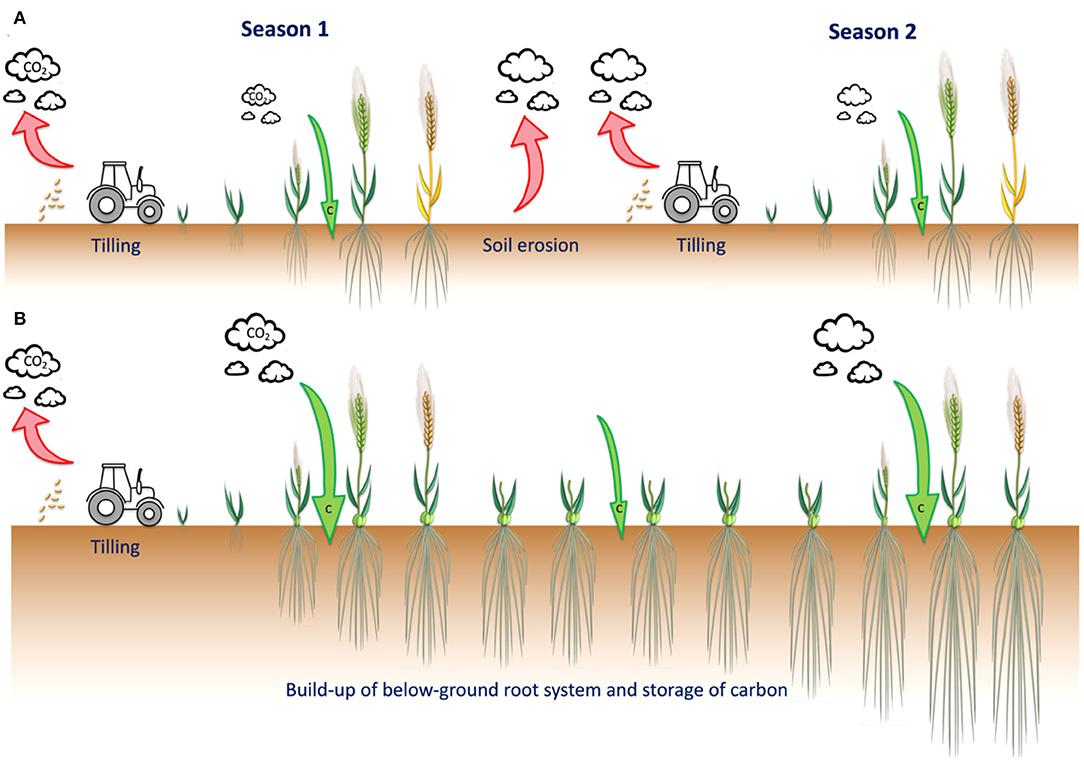Perennial Staple Crops
Perennial staple crops are food crops that can be grown year-round without needing to be replanted each season. These crops offer a sustainable alternative to annual crops, helping to reduce greenhouse gas emissions, improve soil health, and enhance food security.

A perennial grain crop would offer a sustainable alternative to present day annual crops (Frontiers)
View open jobs in this Solution
Example Organizations
- The Land Institute - Pioneers in developing perennial grain crops like Kernza.
- Rodale Institute - Promotes organic farming and perennial crop research.
- Ceres - Advocates for sustainable agriculture and resilient food systems.
Overview
In the last decade, significant progress has been made in developing perennial staple crops to reverse climate change. Breakthrough technologies such as genetic engineering and synthetic biology have enabled the development of crops that are more resistant to drought and pests, and require less fertilizer and water. These crops have contributed to the reduction of greenhouse gas emissions by reducing the need for chemical inputs and by sequestering carbon in the soil.
Organizations such as the Land Institute and the Rodale Institute have been at the forefront of this solution, developing and promoting the use of these crops. Companies such as Monsanto and DuPont have also been involved in the development of these crops, and are now beginning to commercialize them.
Progress Made
Significant advancements have been made in developing perennial staple crops:
- Genetically Modified Crops: Crops engineered to be more resistant to drought and pests, reducing the need for water and pesticides.
- New Irrigation Systems: Efficient irrigation systems that use less water.
- Crop Rotation Systems: Reducing the need for tilling, which releases greenhouse gases.
- Cover Crops: Reducing soil erosion and improving soil health.
Solutions by Sector
Agricultural Practices
- Perennial Grains: Developing grains like Kernza that do not need to be replanted each year.
- Agroforestry: Integrating trees and shrubs into agricultural landscapes for perennial crop production.
- Soil Health Management: Using cover crops and reduced tillage to improve soil health and carbon sequestration.
Case Studies:
- The Land Institute, USA: Developing Kernza, a perennial grain with deep roots that sequester carbon (The Land Institute). While promising, the scalability and economic viability of Kernza remain challenges.
- Rodale Institute, USA: Promotes organic farming and perennial crop research (Rodale Institute). Despite its benefits, organic farming can face challenges related to yield and market access.
- Ceres, Global: Advocates for sustainable agriculture and resilient food systems (Ceres). Ceres' initiatives are commendable, but the implementation of sustainable practices on a large scale requires significant investment and policy support.
Technological Innovations
- Genetic Engineering: Developing crops with enhanced growth and resilience.
- Synthetic Biology: Engineering microorganisms to support perennial crop growth.
- Precision Agriculture: Utilizing data and technology to optimize perennial crop management.
Case Studies:
- Monsanto's Bioenergy Crops, USA: Developing genetically engineered crops for bioenergy (Monsanto). Monsanto's involvement in bioenergy is controversial due to its history of environmental and social issues.
- Syngenta's Crop Protection, Switzerland: Provides seeds and crop protection products for perennial crops (Syngenta). Syngenta's practices have faced scrutiny for their environmental impact and reliance on chemical inputs.
- DuPont's Cellulosic Ethanol, USA: Produces cellulosic ethanol from perennial crops (DuPont). DuPont has faced criticism for its environmental practices and the sustainability of its biofuel production.
Environmental and Social Impact
- Climate Change Mitigation: Perennial crops sequester carbon in the soil, reducing greenhouse gas emissions.
- Biodiversity Conservation: Perennial crops provide habitat for various species and improve ecosystem health.
- Community Engagement: Involving local communities in the development and management of perennial crops.
Case Studies:
- Kernza Grain, USA: Developed by The Land Institute, Kernza is a perennial grain that sequesters carbon and improves soil health (The Land Institute). While promising, the scalability and economic viability of Kernza remain challenges.
- Agroforestry in Brazil: Integrating trees into agricultural systems for perennial crop production and carbon sequestration (Embrapa). Agroforestry has multiple benefits but requires careful management to avoid negative impacts on local ecosystems.
- Cover Cropping for Biomass, USA: Using cover crops to improve soil health and provide biomass (NRCS). Cover cropping is beneficial but may not be feasible for all farming systems.
Lessons Learned
- Management Approach: Perennial staple crops require a different management approach than annual crops, necessitating farmer training.
- Environmental Suitability: Selecting the right type of perennial crop for specific climate and soil conditions is crucial.
- Long-Term Investment: Perennial crops are a long-term investment that requires patience and commitment.
- Environmental Impact: Consider the environmental impact, including land and water use, before large-scale implementation.
Challenges Ahead
- Knowledge and Awareness: Educating and training farmers on how to grow and care for perennial crops.
- Land Availability: Finding suitable land for large-scale perennial crop production.
- High Costs: Developing and implementing perennial crops requires significant investment.
- Political Will: Lack of government policies and programs to support and promote perennial crops.
Best Path Forward
- Public Awareness: Increase awareness of the benefits of perennial staple crops among farmers, policymakers, and the public.
- Financial Incentives: Provide financial incentives to encourage farmers to adopt perennial staple crops.
- Research and Development: Invest in R&D to develop better perennial crop varieties and management practices.
- Policy Support: Collaborate with governments to create supportive policies for perennial staple crops.
- Demonstration Projects: Establish demonstration projects to showcase the potential of perennial staple crops.
Prominent supporters include The Land Institute, Ceres, and The Nature Conservancy.
Image credit: Frontiers